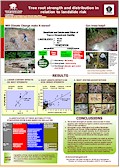| Poster |
 |
|
| Title | Tree root strength and distribution in relation to landslide risk | | Author | Kurniatun Hairiah, Ari Santosa Pamungkas, Widianto, Didik Suprayogo, Veronika Kurniasari, Syahrul Kurniawan and Meine van Noordwijk | | Year | 2008 | | Publisher | World Agroforestry Centre - ICRAF, SEA Regional Office | | City | Bogor, Indonesia | | Call Number | PO0138-08 | | Keywords | Root Reinforcement, Index of Rooting Depth, Root Mapping, Riparian Vegetation, Slope Stability |
|
| Abstract: |
| Mass movement of soil on steep slopes or ‘landslides’ can be destructive for any vegetation or people in the downhill pathway and can be a major contributor of sediment load in the river systems. A combination of deep rooted trees for anchoring and shallow rooted grass (for stabilizing topsoil) is generally perceived to stabilize slopes prone to mass movement. In the context of a broad evaluation of the role of agroforestry in maintaining or restoring watershed functions in the humid tropics, we tested hypotheses at four scales (individual (woody) roots, rooted volumes of soil, tree root systems and riparian vegetation):
(1) The critical load where individual roots break is related to the roots’ lignin content and similar properties,
(2) The shear strength of a volume of soil over any plane increases proportionally with the number and strength of individual roots,
(3) Within a similar overall ratio of woody root to stem cross sectional area, there are consistent differences between tree species in root development in the topsoil and at depth, that contribute to differences in soil binding and soil anchoring, respectively,
(4) Differences in the distribution of tree roots between species can be used to reduce landslide risks in the context of productive coffee agroforestry systems.
Hypotheses 1 was confirmed, with a five-fold variation in strength of roots of 2 mm diameter: The break strength of roots across 5 species was related (81% of variation accounted for) to lignin content + 0.76 * N – 0.07 * Polyphenol content, while lignin content alone accounted for 70% of the variation. Mahogani (Swietenia mohogani) and coffee (Coffea canephora) had the strongest roots, gmelina (Gmelina arborea) and suren (Toona surensis) the lowest, and giant bamboo (Bambusa arundinacea) intermediate root strength. Hypotheses 2 was partially confirmed in tests of the force that can be laterally applied to a soil column before it breaks. Soil shear strength (kPa) depends on soil texture and soil water content; across five plant species Coffea canephora (coffee), Gliricidia sepium (‘kayu hujan’), Maesopsis eminii (‘pohon afrika’), Artocarpus heterophyllus (jackfruit), and Bambusa arundinacea (bamboo) were compared to a ‘fallow vegetation’ (dominated by Trema orientalis (‘anggrung’) and Melastoma (‘harendong’) and the edges of rice fields. Results of our measurements show that soil shear strength was indeed correlated with a tree root length density (Lrv). Overall, bamboo plots showed the largest shear strength. As the plants tend to occur on soils of different texture, however, indexing shear strength by texture clarified the role of fine roots across species. After accounting for other soil and factors, an index of root development top soil layer (0 – 5 cm) accounted for 60% of the variation in soil shear strength in that layer. As test of Hypothesis 3, an Index of Root Anchoring (IRA) was calculated as ? Dv2 /dbh2 where dbh is tree diameter at breast height and Dv is the diameters of vertical roots. The highest IRA was observed on unpruned coffee (7.7), while pruning stimulates formation of roots in the surface layer. Three other tree species (Artocarpus elasticus, Parkia speciosa and Durio zibethinus) of the coffee agrofore
stry systems had a high IRA value (>1.0), and tend to grow to larger dbh values, providing more anchoring than coffee on a per tree basis. The common shade trees (legume) in coffee agroforestry system i.e. Gliricidia sepium and Erythina subumbrans and the tree most frequently used for government reforestation programs in the past, Calliandra calothyrsus, have low IRA values, indicating little ‘soil anchoring’; other timber and fruit trees had intermediate IRA values. Trees with a high IRA can probably be used to anchor river banks when grown to mature size. Ideally planting a mix of tree species with different pattern of rooting depth will provide a good protection of the soil surface and also increase river bank stability. Based on this preliminary study, we suggest a mix of tree species with deep roots and grasses with intense fine roots will provide the highest river bank stability in the area (Hypothesis 4). |
|